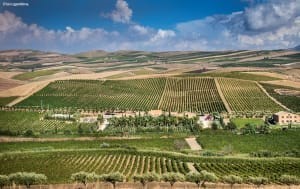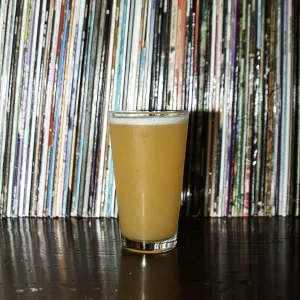The alcoholic beverage industry is leaning into AI in more ways than you think
July 20, 2024
The alcoholic beverage industry is leaning into AI in more ways than you think
From flavor innovation to planning for disruptive weather events, booze brands are getting tipsy on the artificial intelligence boom.
BY John Kell
With rising global temperatures posing a threat to agriculture, some wineries are turning to artificial intelligence to better prepare for unpredictable weather patterns.
“AI is helping us be more resilient,” says Will Drayton, director of sustainability and science at Treasury Wine Estates. “So it doesn’t stop climate change, but helps us to be more resilient in the face of climate change.”
The Beringer and Matua winemaker is using AI today to help model “what if” scenarios to more nimbly plan for huge swings in temperature that drastically impact yield during the harvest season. AI can also help predict fermentation conditions and improve irrigation methods.
Morning sunrise
Alcoholic beverage brands are still in the early innings of deploying AI, and beyond improvements to irrigation, an increasing number of companies are using the technology to inform the chemistry that goes into making a wine, beer, or spirit, with the ultimate goal of creating new brands or flavors that will be a hit with consumers.
The industry could certainly use a lift. Global demand for alcoholic beverages declined in 2023, with scant growth projected for this year and 2025, according to data and insights provider IWSR.
In the United States, younger adults are drinking less alcohol than prior generations, a trend that’s impacting each industry differently. Beer has been badly bruised for years, with consumption at its lowest annual level since 1999. Winemakers are struggling to attract millennials and Gen Z drinkers. And even the more resilient liquor industry posted its first decline in volume in 2023 in nearly 30 years, IWSR reports.
Treasury says some of the more advanced technologies—including automation and robotics—that it deploys tend to favor larger brands, like Beringer. But many of the AI investments permeate across the company’s portfolio in the U.S. and markets abroad including Australia and New Zealand.
The company uses AI for more precise irrigation. Sensors keep track of the water pressure and flag when lines may be inefficient, like when coyotes chew through drip lines. The data flows through AI models that make recommendations on when to address the problems.
“With the 100-plus-degree weather that we’re having in California right now, being on top of irrigation issues obviously saves yield and quality,” Drayton says.
Sicilian-based winery Donnafugata similarly uses the technology to help combat the invasion of European moths. Twice a day, a camera takes a photo, which is processed by AI, to recognize the insects and predict their growth. That data helps inform a more aggressive defense strategy.

The winery also combines microclimate data like humidity, wind, and atmospheric pressure, and combines that with weather forecasts of up to 10 days to help Donnafugata plan for how to respond to adverse climate change. Antonio Rallo, co-owner and CEO of Donnafugata, says AI “ultimately translates into the adoption of more sustainable practices.”
Drinkers don’t always know what they like
Katerina Axelsson, CEO and founder of tech startup Tastry, says wineries often unnecessarily take on too much risk when launching new labels. Historically, the industry ascertains category data from analytics firm Nielsen to see what has sold well in the past, then develops a copycat brand in hopes of scoring a hit.
“I thought that was woefully insufficient,” Axelsson says.
Tastry uses AI to analyze wine blends and run simulations to determine how many different renditions of that blend a winery could make, and guide it toward the best possible chemistry that would align with consumer preferences.
“Traditionally, it seems like consumers are put into archetypes, with metadata that isn’t necessarily tied to whether or not they even like that wine,” Axelsson says. “We see you as unique as a fingerprint.”
Liquor giant Diageo says one of its most developed use cases for AI is predicting flavor preferences. In 2022, it acquired Vivanda and has since expanded the “What’s Your Whiskey” platform that lets drinkers take a short quiz to discover the spirit that best matches their palate.
“What’s Your Whiskey” is now available in 26 countries and 60 different languages, and similar AI tools have been unveiled for beer and cocktails. Tequila will be next.
“The ability to use that data with AI to understand more precisely where we should be targeting our innovation, and even just what are the right cocktails to be serving in different locations . . . is a capability that’s going to set us up really well for the future,” says Mark Sandys, Diageo’s chief innovation officer.
It has also led to some counterintuitive discoveries. The AI data showed fruity whiskeys were a hit with consumers, who tend to tell market researchers that they prefer smoky flavors. Along those lines, Buchanan’s pineapple-flavored Scotch has been Diageo’s biggest flavor launch in North America this year.
Diageo also works with a startup called AI Palette, which feeds data from social media and food and beverage trends into an AI system to predict the next hot flavor. This year, the two flavor trends Diageo is homing in on are umami and another called “bloom harvest,” which includes jasmine, lavender, and hibiscus.
“That’s something that we’re doing more and more to try and predict where the consumer is going to be,” Sandys says, adding that Diageo can then plan product innovation and cocktail promotions that align with the flavors drinkers are gravitating toward.
Analyze my beer
Earlier this year, Belgian scientists published research that analyzed 250 different beers and trained machine learning models to predict flavor and consumer preference. For each beer, the scientists from research university Ku Leuven measured 226 chemical properties, including alcohol content, sugar, and flavors such as caramel, citrus, tropical fruit, and banana.
They also analyzed more than 180,000 consumer reviews from online rating platform RateBeer to train 10 different AI models.
“When it comes to machine learning, we saw that you can predict flavor reasonably well,” says Michiel Schreurs, a junior researcher and PhD candidate for microbiology at Ku Leuven.
The AI models showed particular promise in predicting flavor for nonalcoholic beers, and for alcoholic offerings the models proved to be best at predicting acidity and alcohol content. Aromas proved more difficult, and because the study was limited to Belgian breweries, which produce ales that are known to be yeast-forward in taste.
Stateside, the Bruery, Species X Beer Project, and Asbury Park Brewery have unveiled beers created in collaboration with AI recipes with funny labels that are almost too on the nose, including “AI-IPA,” “A.I.P.A,” and “Darw1n.”

Bob McLynn, founder of Asbury Park Brewery, says his New Jersey-based facility set out to create a new hazy IPA. As a starting point, it relied on a recipe churned out by Microsoft Copilot AI before making some tweaks to the alcohol content and grains used to make the beer. The chatbot had sought to make the beer a lot stronger than McLynn would have liked.
And while AI-IPA is a strong seller at the brewery’s taproom, McLynn says AI-fueled innovation will only go so far, noting, “Humans will continue to lead the charge in creating beers and new styles.”
ABOUT THE AUTHOR
Fast Company
(12)



